technical data MERCEDES-BENZ SPRINTER 2015 MY15 Audio Manual
[x] Cancel search | Manufacturer: MERCEDES-BENZ, Model Year: 2015, Model line: SPRINTER, Model: MERCEDES-BENZ SPRINTER 2015Pages: 54, PDF Size: 1.14 MB
Page 5 of 54
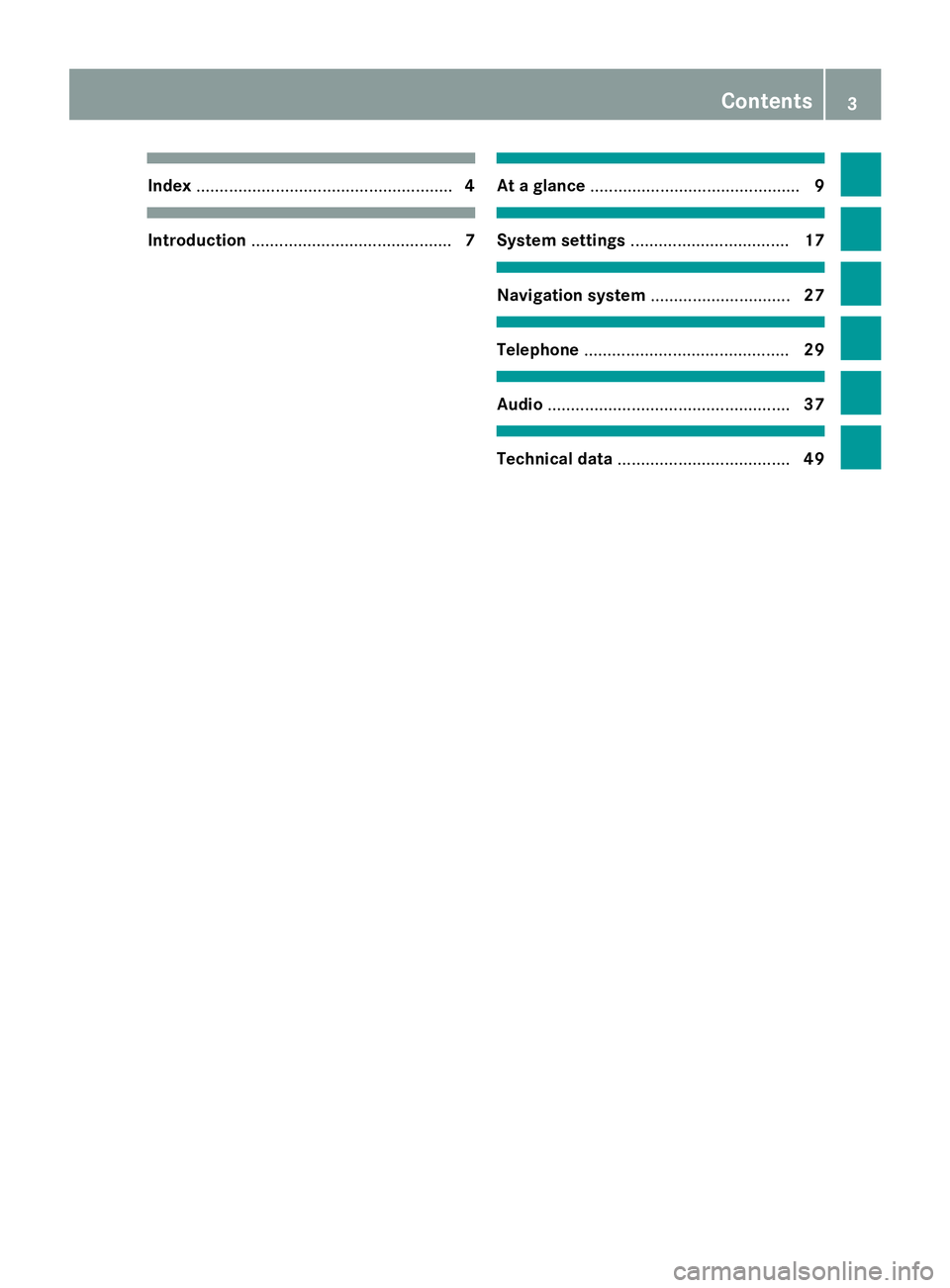
Index
....................................................... 4Introduction
........................................... 7 At a glance
............................................. 9 System settings
.................................. 17 Navigation system
..............................27 Telephone
............................................ 29 Audio
.................................................... 37 Technical data
..................................... 49 Contents
3
Page 10 of 54
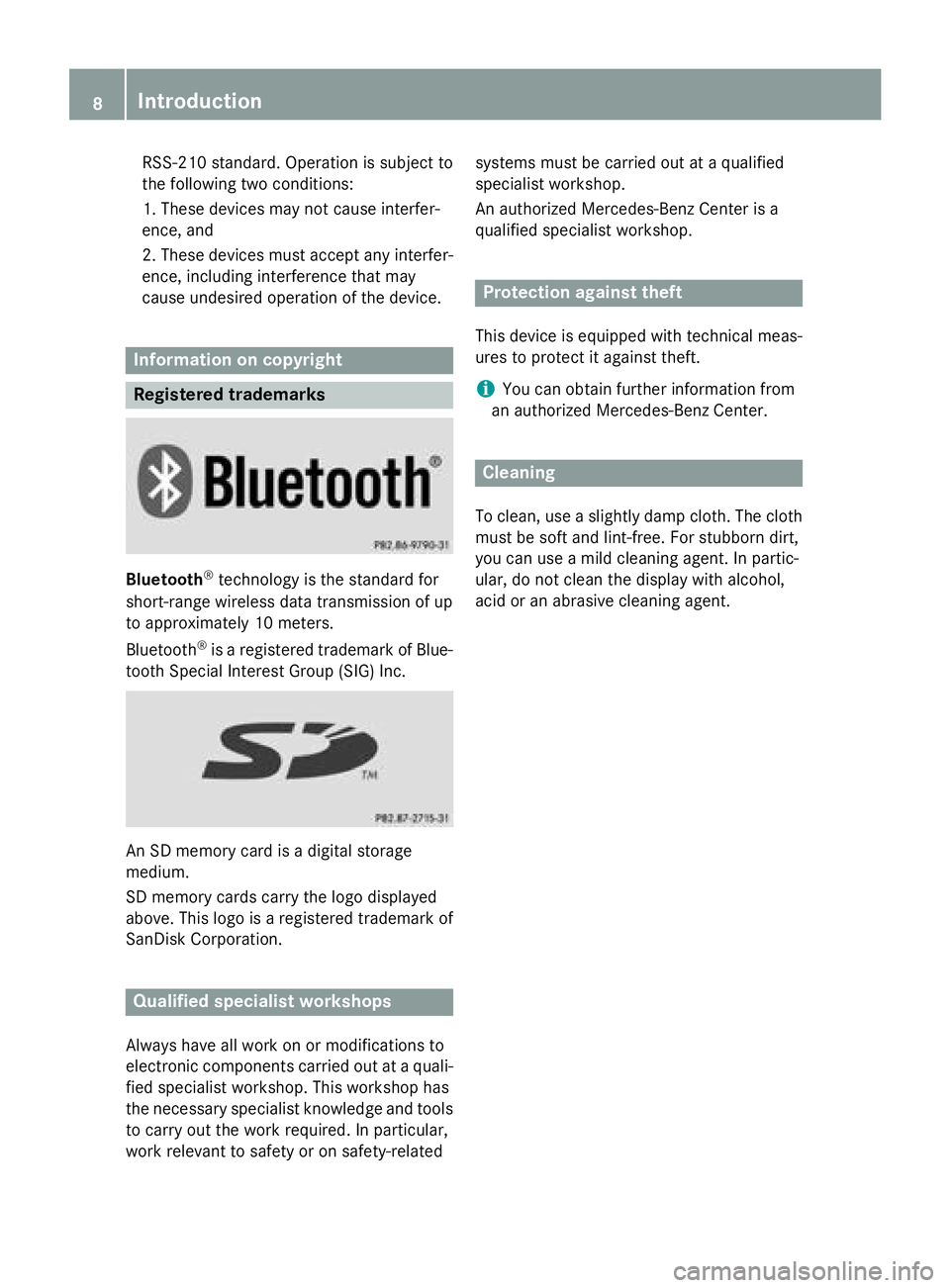
RSS-210 standard. Operation is subject to
the following two conditions:
1. These devices may not cause interfer-
ence, and
2. These devices must accept any interfer-
ence, including interference that may
cause undesired operation of the device. Information on copyright
Registered trademarks
Bluetooth
®
technology is the standard for
short-range wireless data transmission of up
to approximately 10 meters.
Bluetooth ®
is a registered trademark of Blue-
tooth Special Interest Group (SIG) Inc. An SD memory card is a digital storage
medium.
SD memory cards carry the logo displayed
above. This logo is a registered trademark of
SanDisk Corporation. Qualified specialist workshops
Always have all work on or modifications to
electronic components carried out at a quali- fied specialist workshop. This workshop has
the necessary specialist knowledge and tools
to carry out the work required. In particular,
work relevant to safety or on safety-related systems must be carried out at a qualified
specialist workshop.
An authorized Mercedes-Benz Center is a
qualified specialist workshop. Protection against theft
This device is equipped with technical meas-
ures to protect it against theft.
i You can obtain further information from
an authorized Mercedes-Benz Center. Cleaning
To clean, use a slightly damp cloth. The cloth must be soft and lint-free. For stubborn dirt,
you can use a mild cleaning agent. In partic-
ular, do not clean the display with alcohol,
acid or an abrasive cleaning agent. 8
Int
roduction
Page 42 of 54
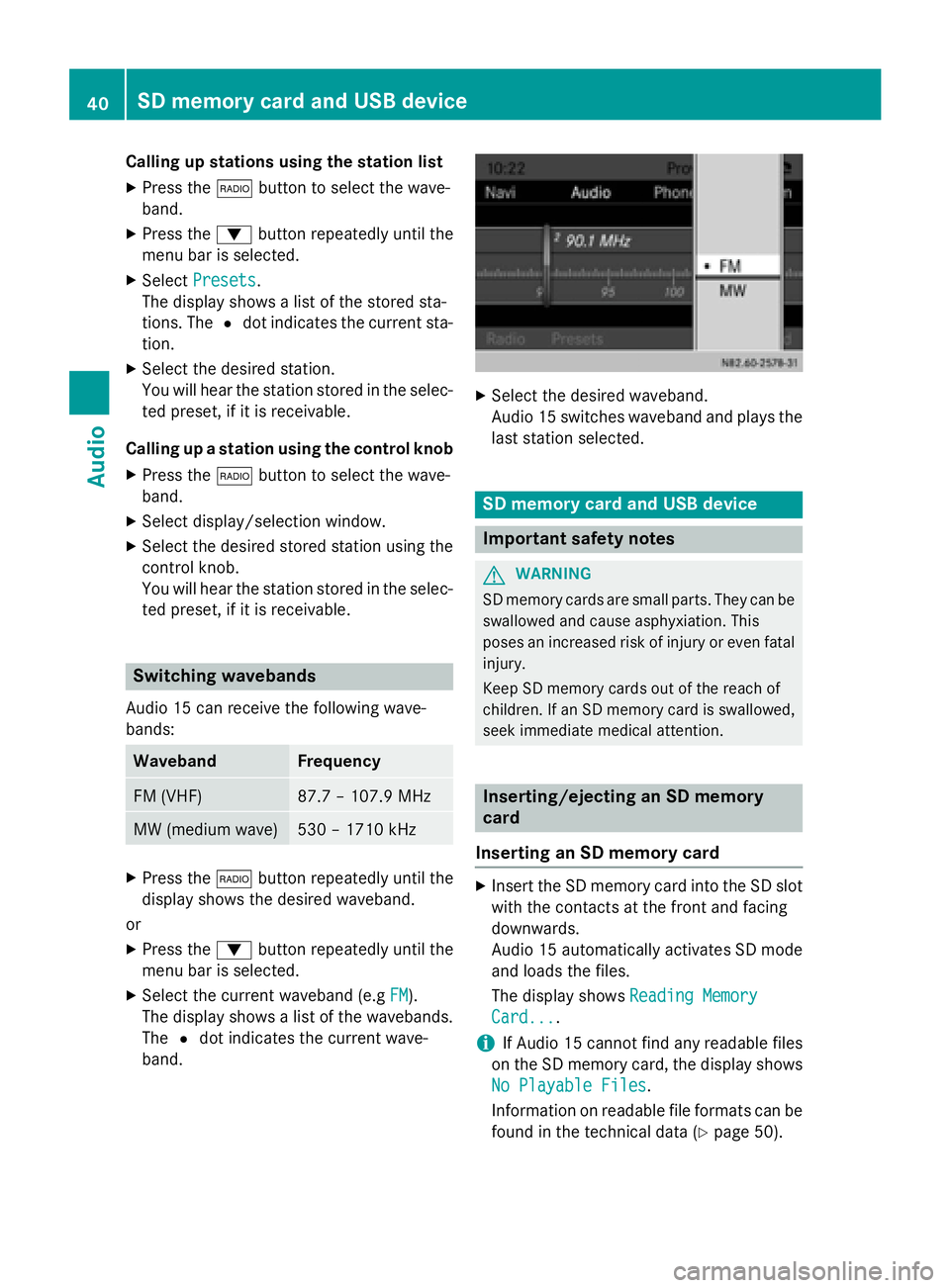
Calling up stations using the station list
X Press the 002Abutton to select the wave-
band.
X Press the 0064button repeatedly until the
menu bar is selected.
X Select Presets
Presets.
The display shows a list of the stored sta-
tions. The 0036dot indicates the current sta-
tion.
X Select the desired station.
You will hear the station stored in the selec-
ted preset, if it is receivable.
Calling up a station using the control knob
X Press the 002Abutton to select the wave-
band.
X Select display/selection window.
X Select the desired stored station using the
control knob.
You will hear the station stored in the selec- ted preset, if it is receivable. Switching wavebands
Audio 15 can receive the following wave-
bands: Waveband Frequency
FM (VHF) 87.7 – 107.9 MHz
MW (medium wave) 530 – 1710 kHz
X
Press the 002Abutton repeatedly until the
display shows the desired waveband.
or X Press the 0064button repeatedly until the
menu bar is selected.
X Select the current waveband (e.g FM FM).
The display shows a list of the wavebands.
The 0036dot indicates the current wave-
band. X
Select the desired waveband.
Audio 15 switches waveband and plays the
last station selected. SD memory card and USB device
Important safety notes
G
WARNING
SD memory cards are small parts. They can be swallowed and cause asphyxiation. This
poses an increased risk of injury or even fatal injury.
Keep SD memory cards out of the reach of
children. If an SD memory card is swallowed,
seek immediate medical attention. Inserting/ejecting an SD memory
card
Inserting an SD memory card X
Insert the SD memory card into the SD slot
with the contacts at the front and facing
downwards.
Audio 15 automatically activates SD mode
and loads the files.
The display shows Reading Memory Reading Memory
Card...
Card....
i If Audio 15 cannot find any readable files
on the SD memory card, the display shows
No Playable Files
No Playable Files.
Information on readable file formats can be found in the technical data (Y page 50).40
SD memory card and USB deviceAudio
Page 43 of 54
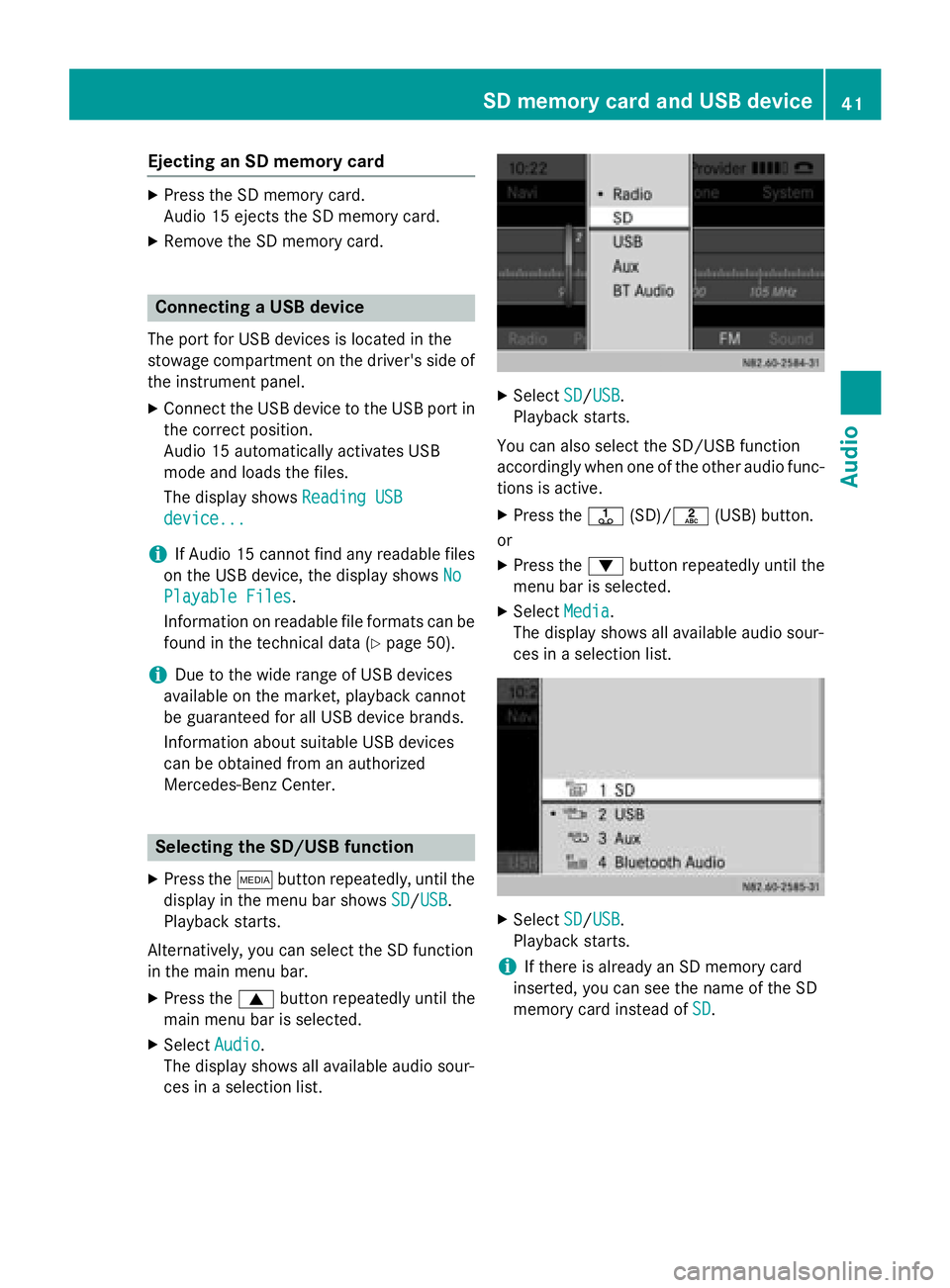
Ejecting an SD memory card
X
Press the SD memory card.
Audio 15 ejects the SD memory card.
X Remove the SD memory card. Connecting a USB device
The port for USB devices is located in the
stowage compartment on the driver's side of
the instrument panel.
X Connect the USB device to the USB port in
the correct position.
Audio 15 automatically activates USB
mode and loads the files.
The display shows Reading USB Reading USB
device...
device...
i If Audio 15 cannot find any readable files
on the USB device, the display shows No
No
Playable Files
Playable Files.
Information on readable file formats can be
found in the technical data (Y page 50).
i Due to the wide range of USB devices
available on the market, playback cannot
be guaranteed for all USB device brands.
Information about suitable USB devices
can be obtained from an authorized
Mercedes-Benz Center. Selecting the SD/USB function
X Press the 00FDbutton repeatedly, until the
display in the menu bar shows SD
SD/USB USB.
Playback starts.
Alternatively, you can select the SD function
in the main menu bar.
X Press the 0063button repeatedly until the
main menu bar is selected.
X Select Audio
Audio.
The display shows all available audio sour-
ces in a selection list. X
Select SD SD/USB
USB.
Playback starts.
You can also select the SD/USB function
accordingly when one of the other audio func-
tions is active.
X Press the 0080(SD)/0082 (USB) button.
or
X Press the 0064button repeatedly until the
menu bar is selected.
X Select Media Media.
The display shows all available audio sour-
ces in a selection list. X
Select SD SD/USB
USB.
Playback starts.
i If there is already an SD memory card
inserted, you can see the name of the SD
memory card instead of SD
SD. SD memory card and USB device
41Audio Z
Page 51 of 54
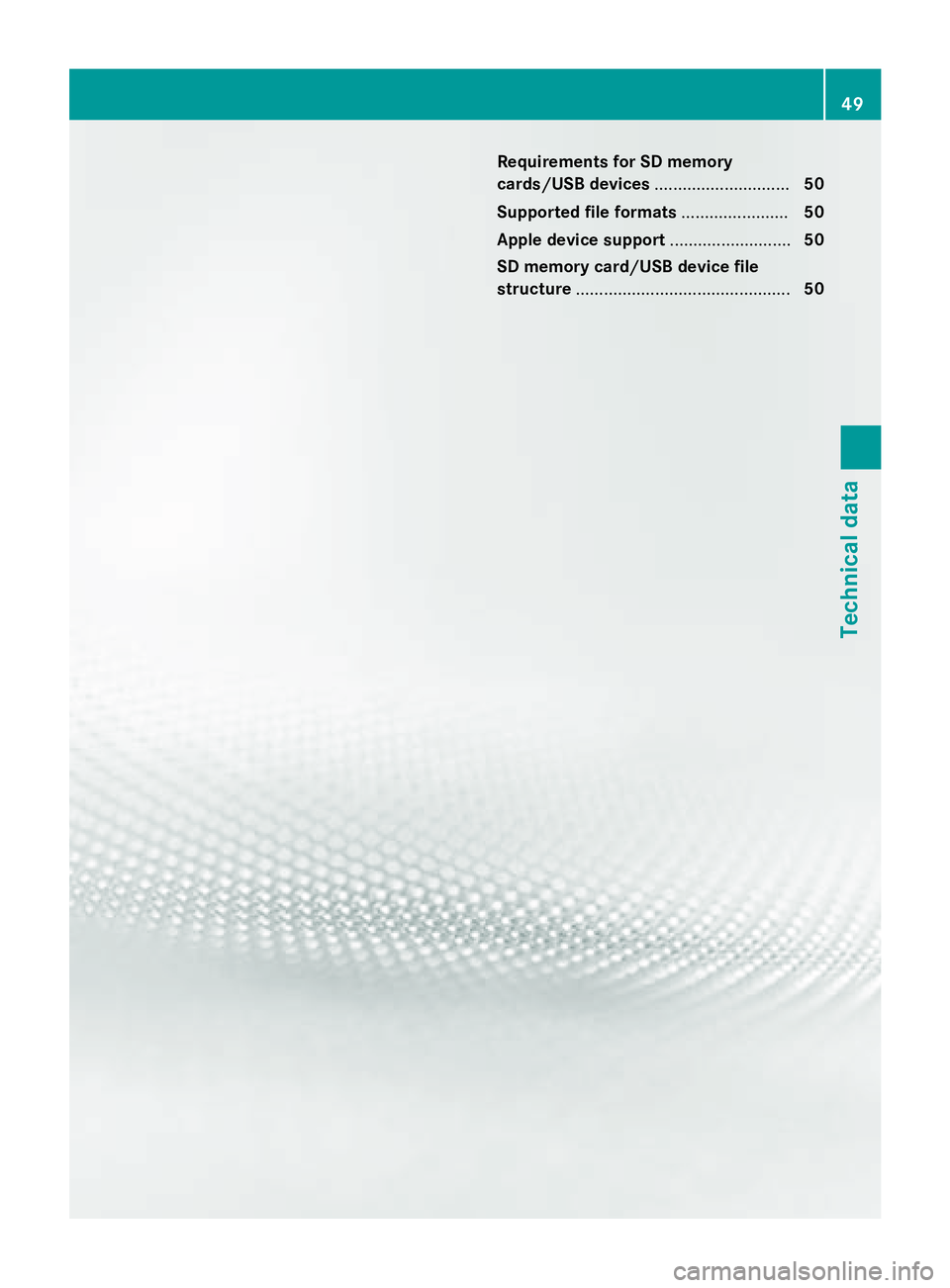
Requirements for SD memory
cards/USB devices
.............................50
Supported file formats .......................50
Apple device support ..........................50
SD memory card/USB device file
structure .............................................. 50 49Technical data
Page 52 of 54
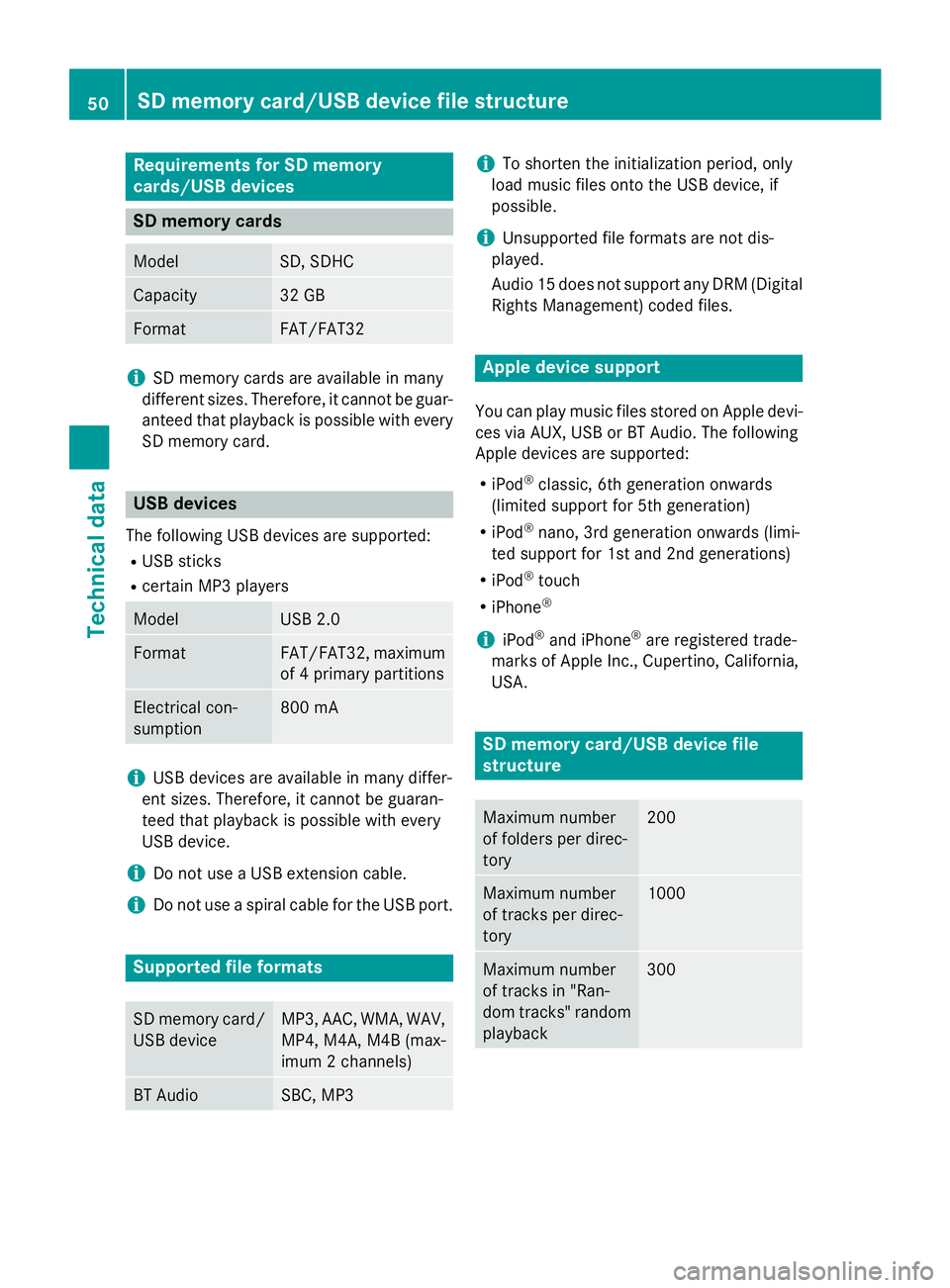
Requirements for SD memory
cards/USB devices
SD memory cards
Model SD, SDHC
Capacity 32 GB
Format FAT/FAT32
i
SD memory cards are available in many
different sizes. Therefore, it cannot be guar-
anteed that playback is possible with every SD memory card. USB devices
The following USB devices are supported: R USB sticks
R certain MP3 players Model USB 2.0
Format FAT/FAT32, maximum
of 4 primary partitions Electrical con-
sumption 800 mA
i
USB devices are available in many differ-
ent sizes. Therefore, it cannot be guaran-
teed that playback is possible with every
USB device.
i Do not use a USB extension cable.
i Do not use a spiral cable for the USB port. Supported file formats
SD memory card/
USB device MP3, AAC, WMA, WAV,
MP4, M4A, M4B (max-
imum 2 channels) BT Audio SBC, MP3 i
To shorten the initialization period, only
load music files onto the USB device, if
possible.
i Unsupported file formats are not dis-
played.
Audio 15 does not support any DRM (Digital Rights Management) coded files. Apple device support
You can play music files stored on Apple devi-
ces via AUX, USB or BT Audio. The following
Apple devices are supported:
R iPod ®
classic, 6th generation onwards
(limited support for 5th generation)
R iPod ®
nano, 3rd generation onwards (limi-
ted support for 1st and 2nd generations)
R iPod ®
touch
R iPhone ®
i iPod ®
and iPhone ®
are registered trade-
marks of Apple Inc., Cupertino, California,
USA. SD memory card/USB device file
structure
Maximum number
of folders per direc-
tory 200
Maximum number
of tracks per direc-
tory 1000
Maximum number
of tracks in "Ran-
dom tracks" random
playback 30050
SD memory card/USB device file structureTechnical data